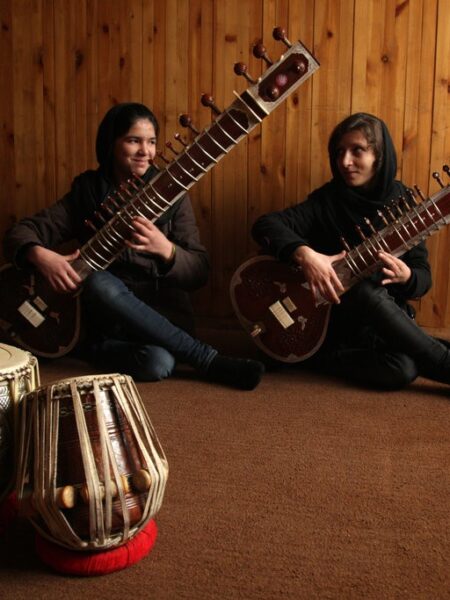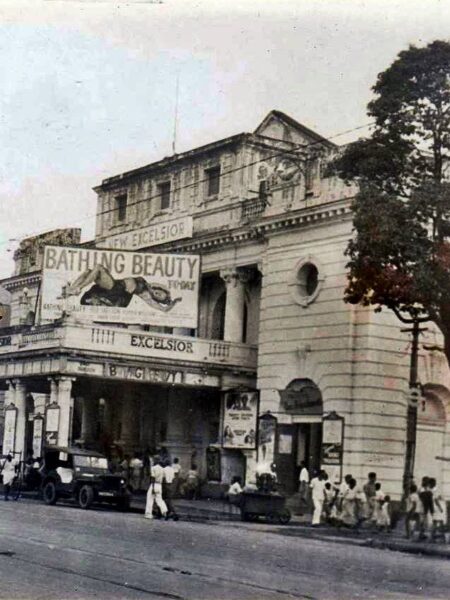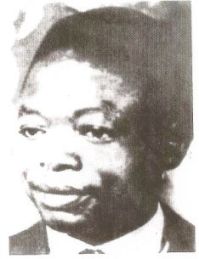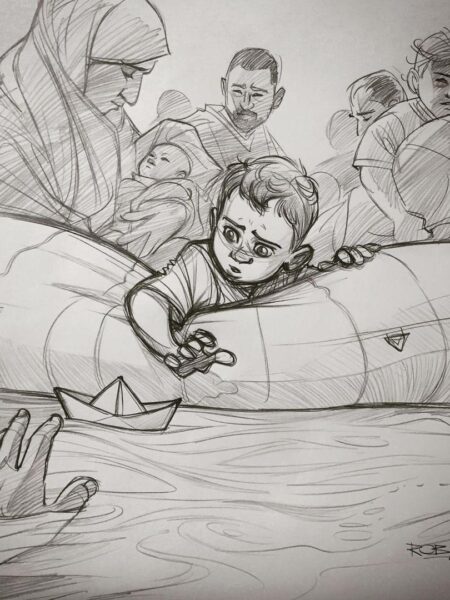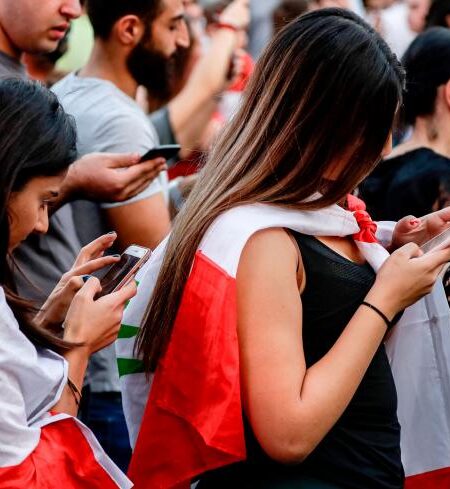Starting with a blast
Three months after it was postponed due to COVID-19 safety restrictions, with over ten thousand attendees and lasting approximately half a day, the Rap Việt All-Star Concert 2021 is considered as one of the most successful music festivals in Vietnam and perhaps the biggest rap concert to be publicly organized[1]. This might be considered as a valuable starting point for reflecting on the evolution of this music genre that has garnered worldwide acclaim, notably with the participation of young people and adolescents. Furthermore, with notable rappers such as Suboi, Wowy, and Datmaniac making appearances on international music shows, it is about time to reflect on the evolution of Vietnamese rap, from a subcultural music taste favoring rebellious youths to a nation-wide accepted phenomenon that sparks great opportunities for the music industry.
Globalization has been discussed and defined in a range of social science and humanities subfields, spanning economics, sociology, anthropology, and international relations studies. For this research, I used the cultural globalization approach to explore the factors by which a particular tangible or intangible cultural subject (typically the one which had already been popularized or considered as popular culture) had been adapted to a specific identified region (in this scenario, Vietnam), and whether or not it had altered the previous cultural landscapes of that region (Crothers 2017, 27-32). Besides, I used three additional perspectives for this project: (1) localization, the process by which a cultural subject has been modified to fit regional characteristics and contexts [2]; (2) glocalization, the process for which a cultural aspect adapts to the local context while maintaining the global key characteristics [3] and (3) Americanization, a form of globalization that is more likely based on worldwide acknowledge characteristics imposed to other countries by the American’s soft power media [4]. When approaching such an obscure, statistically non – quantifiable phenomenon like rap and hip-hop culture, these four concept theories would eventually broaden the binary perspective and help construct a better vision of diverse narratives.
Understanding diverse narratives about Vietnamese rap

Many issues have been raised to critically analyzing the evolution of this music genre in Vietnam: How, by definition, has a black diasporic spoken poetry art form [5] been widely recognized in Vietnam in recent years? How has globalization influenced the progress of the Vietnamese rap scene from the 1990s to the present? How have globalization and the development of Vietnamese Hip-Hop culture influenced the identities of a group of Vietnamese youths? What are the factors that might lead to the emergence of a Vietnamese rap scene if the globalization trend continues?
I put up an open “Call for participation” post on my Facebook account in search of anyone interested in discussing with me this cultural phenomenon and trying to sort out some approaches to explain it with the most diverse pool of thoughts possible[6]. Ultimately, with the help of the online network circulating the news, I received forty-two registrations through the open call. I had successfully conducted twenty-seven interviews with twenty-nine individuals out of those who had registered; twelve registrations did not make it to the talk, and two declined the virtual meeting offer. As for the successful conversations with the narrators, I set up the interviews to be more of a friendly, semi-structured-styled conversation and preferred to listen to the narrators’ points of view rather than guide them to the preferable answer I was looking for in my research[7]. The conversations were mostly divided into two halves: (1) the first was the topic and key terms I had prepared in advance; and (2) the second half was dedicated to creating an open space for the narrators to express their feelings and concerns about the Vietnamese rap scenes in general. The conversations lasted for an hour and a half on average. In terms of the participants’ backgrounds, twenty-seven introduced themselves, first and foremost, as “Vietnamese rap enthusiasts” rather than pointing out their professions that are related to rap, such as rappers, hip-hop journalists, or Facebook rap-content page administrators. This can be described as a focus group with people who had spent a considerable amount of time on the spatial and temporal limitations of the project, bringing in their deep thoughts about the issues raised by both themselves and the researcher.

Furthermore, I want to take this opportunity to highlight some significance of the Internet, the fundamental platform I use as both the medium to connect with the narrators and the most important place to trace primary sources on the research topic. The Internet comprises of two main parts: the top layer, or the visual contents shown on a computer screen, and the beneath layer, which contains a series of binary numeral codes that help to deliver the top layer to the users’ eye (Bru¨gger 2018, 33-36). For the scopes of this report, we will only use the term to refer to the top layer, also known as the visual contents, that appeared on screen, such as fandoms, online news articles, videos, and music played via certain platforms, or photographs shot and uploaded on social media accounts. The Internet not only functioned as one of the legitimate sources for identifying a growing younger generation’s attraction to digital information, but it also revealed how intimately humans can interact with one another despite geographical distance. I had the opportunity to speak with individuals outside of Sài Gòn (or Hồ Chí Minh City). Some narrators were based in Hà Nội, Northern Vietnam, while others were from the northern Mekong provinces. This was also the spatial constraint I established for this research in terms of understanding the perspectives of rap enthusiasts who had spent their childhood experiences in Vietnamese society. Furthermore, because of the effects of COVID-19 on personal travel, I was unable to easily access physical documents in the archive center or read printed news articles in public libraries. The Internet, therefore, functions as a digital archive repository for the many documents I needed, as well as additional assistance in correlating the narrators’ information with other sources including media articles or music productions. In the following three parts of this report, I will dive deep into three tiers of what I consider (1) the process of gaining knowledge, (2) the understanding the culture and how it has formed a new narrative of youth identity, and (3) the reflection on how Vietnamese rap has been practiced and contributed to the audience across time.
Keeping up with the World Wide Web

As I had aforementioned, one of the most major milestones that shaped the new Vietnamese generation was the public launch of the Internet in 1997, preceding more than a decade of economic reforms (Đổi Mới period) and expanding foreign collaborations[8]. It was one of many efforts promoted by the government to reach out with global corporations such that people can better exchange information and ideas even while strengthening the country’s economy. From this year onwards, if a family was categorized as “middle-income,” they might well have diversified their entertainment activities in addition to the traditional technological media such as tv and radio. When the younger generations had already become familiarized with the easy-to-access platform, they would gradually replace other separate means of entertainment with a more flexible one that comprised all the applications they desired. Hence, the Internet acted as the platform for the cultural globalization process to take hold in Vietnamese society. Tài[9], a twenty-year-old college student who was born in the countryside, got his first chance to listen to rap through the rap video called Đưa nhau đi trốn by Đen Vâu and Linh Cáo in 2015[10]. He explained that in his area, the Internet was only available at the “net store” (a place where most of the computers were reserved for the whole local community to use the internet in the early 2000s) opposite his high school. Many of his peers, especially the boys, tended to come to this store to play games or surf the Internet. This was a common activity for other narrators growing up in both the city and the countryside as their families did not have personal computers at home or were able to install Internet broadband at their homes. Consequently, these collective “Internet hotspots” created a chain-reaction process, serving as a medium for students to exchange the concepts of “rap” and “hip hop” with their friends. For many narrators who were born in the 1990s, their first exposure to familiarizing themselves with the concept of rap was most likely through the introductions and suggestions of (male) friends in school. Back when Khang was in grade six at high school, a friend introduced him to a rap song called Ba thằng bạn by Karik and Wowy[11]. He looked the song up on the Internet but did not enjoy it at first. But he got to know what rap was and ultimately resurrected the Internet to look for other rap songs and connected himself with this music genre roughly ten years after it emerged. The Internet could be considered as an open resource for these narrators to actively come and seek for their rap songs whenever they want, rather than just being curated by the obligated agendas provided by state media.
Not only did the Internet serve as the primary medium to understand the concept of “rap” and “hip-hop”, for some narrators, it also helped maintain their interests in listening to this music genre through forums, the online platforms that functioned both as a place for information-sharing and for displaying some of the earliest Vietnamese rappers’ productions. Bình recalled logging into a youth forum (LQĐ in abbreviation) that contained many topics such as sports, students’ lives, and comedic stories he was interested in and was one of the first forums he went to listen to rap songs[12]. Later, in the late 2000s and early 2010s, he joined two well-known forums called rappervn.net and vn2rap.com to discuss and listen to early Vietnamese Hip-Hop generation rap songs[13]. Sadly, these forums did not maintain their appearances for long, as in the second half of the 2010s, there was a steady shift to more global platforms like Facebook, YouTube, Soundcloud, or Spotify. For Thanh, the forums were more of beautiful nostalgia, but since they did not comprehensively update their design, or because it was too complicated to access and covered only a specific, regional audience, the younger generation is in favor of a more international platform that can connect a wider range of users[14]. This shift indicated that the Internet first globalized Vietnamese youngsters with the world and then glocalized that information to fit with the local contexts in which many users would engage with this technology.
Freedom of personal expression as an American identity?

We have now reached the second tier of cultural globalization, and for this section, I would dig a little bit deeper into how the narrators understood and constructed their narratives through obtaining information about rap from the Internet. For many narrators like Tốt, what rap had made him so attached to was freedom of expression[15]. It can be observed through how profanity and cursed words are used in rap songs. Tốt remembered that in some of the early days when he listened to rap, he had to hide his phone under the pillow as he was afraid his parents would hear those cursed words coming out of those rap songs or beefs. But for him, that was what rap was about: the true expression of thoughts African Americans put out when they were oppressed by major cruel forces in American society. This may be an acknowledgment of the authenticity of rap, consisting of the freedom of expression made by individuals and commonly portrayed by American rappers. This way of understanding might be affiliated with the concept of Americanization, as the rap cultural flow was imported to Vietnam from the “core” United States of America, recognizing the roots of this cultural movement and implying its relevance to the Vietnamese context [16]. It is also linked with how many narrators when asked about their thoughts on marijuana, joints, and sex, replied that those were “the personal need” and they respected personal choices. Phấn, a female rapper currently based in Sài Gòn, who has also experienced drugs, commented that it was her personal choice and personal responsibility to wisely use those kinds of “illegal substances” and she felt alright when hearing those subjects in rap songs as it was the artist’s decision to express their true emotions[17]. The artists’ personal lives should be separated from the songs they made and if their works were produced gracefully, Phấn did not think using drugs would be a big problem. This emphasized the perspective of an Americanized identity brought about by rap and Hip-Hop culture, because those unpopular narratives were (and still are) regarded as misbehaved, rebellious, and toxic contents that should never have been included in any type of music genre according to the popular narrative.
Additionally, as I tried to expand the narrators’ thoughts on the visual aspects of this cultural phenomenon, I showed all the narrators a photo of a group of teenagers dressed in what I considered “hip-hop fashion” and asked for their thoughts when looking at it. It turns out that most of the narrators viewed the picture as being the old style or the earlier style of hip-hop dressing. Bình stated that he had seen B-boys practicing their moves at Đầm Sen Theme Park wearing oversized pants with metallic gold chains and a snapback ack on previous occasions[18]. And for many narrators who were born in the early 2000s like Phúc, they had never seen that type of dressing in real life and projected that for this generation, you can expect to dress however you like, based on your own fashion taste[19]. This visual analysis may suggest that even though the visual aspects referring to fashion stood for the global vision, the main practice and ideology were predominantly influenced by the American rap characteristics of individualism and freedom of expression.
Commercialized artists vs. “The community”

Lastly, in this final part of the analysis, we would deal with what I argued to be the narrator’s reflections on the upcoming evolution of Vietnamese rap when they had engaged with the Internet as their primary content and spent their time familiarizing themselves with the characteristics they defined as “Vietnamese rap”. This issue eventually dealt with the ultimate separation that, according to Michael Berry (2018, 98) was created by the commercialization of rap music in the late 1980s and early 1990s after the success of “Hip Hop’s First Death,” Rapper’s Delight, “the underground” versus “the mainstream.” Before heading to the debate between the mainstream and the underground, this section will address the impacts of commercialization on rap music and how it may be considered the origin of Vietnamese rap. When I pointed out the term “commercial”[20], none of them viewed this topic as the origin of Vietnamese rap but rather one of the hot topics. But according to Phong Lê, a Vietnamese American entertainer who was first known for the title of rapper Việt Kiều (Vietnamese Overseas Rapper) or the first generation of Vietnamese rappers, stated that he had heard a rap on television back in 1995-1996 before migrating to the United States in 1997 [21]. The rap he heard might refer to the Sprite commercial which is doubtfully rumored to have aired in 1996 [22], a year after the relationship normalization between Vietnam and the United States[23], and approximately two years since Cocal-Cola joined the Vietnamese economic market [24]. Contrary to Phong Lê’s answers, the information shared by many websites and narrators who had mentioned the origin of Vietnamese rap, like Trình a long-time rap listener credited Vietnamese Gangsters performed by Khanh Nhỏ and Thái Việt G to be the first Vietnamese rap song[25]. In the collective memory, many thought that the song was recorded in 1997. Unfortunately, there has been no confirmation from the artist, not to mention that the official release year of the album Portland Love, which consisted of the song, was 2001[26]. The contrast in recognizing Vietnamese rap origins could also impose the main narrative of the American rap identity, portraying it through the authenticity of street visual aspects and representing the artists’ true emotions rather than through a televised advertisement promoting a soft drink. In terms of the thoughts on “commercial” and “commercialization”, many narrators acknowledge that after two successful popular rap contests in 2020, there was a rise of a new generation who could earn a living from promoting products booked by commercial agencies and sustain their careers as professional rappers with stable financial status.
However, the majority of narrators would partly acknowledge rappers’ commercial promotion activity and their opinions scattered across the acceptance spectrum, leaning towards the “against commercialization” side. It came for two main reasons. First, they did not fully support their artists because they were afraid and concerned about the rapper’s individual productions, which had worsened when they had focused on buffing their fame through making advertisements rap. Consequently, rappers would be chained to the demands of their management teams and would not be able to freely express their thoughts (the authenticity of Hip-Hop culture), as commented by Thiện, who had relentlessly rejected watching two rap contests as he did not think that was the authentic rap he had previously experienced[27]. Another concern raised by the narrators was the lack of support for the upcoming generation in “the community” when rappers had become big names in the entertainment industry. This concern is closely related to the success of two commercialized rap contests on television. Đăng, a rap Facebook page administrator, feared that some rappers who joined the competition had once started their careers with no recognition, no accreditation, and in “the community” (a collective symbol for what is more commonly seen as “the underground”) but now they seemed not to care about where they had made their earliest reputations[28]. Together with those who share the same concerns as Đăng, the narratives proposed on the topic of “commercialization” can be seen as a battle between the globalizing force of popular culture and the preservation and nourishment of localized rap communities. On the one hand, they cannot restrain the force built by industry titans, because many rap artists may be able to sustain their careers and fortunes through those competitions. But the worries were also transparent when one dominant cultural flow was more impactful than the other.
Concluding with an obscure future

The aim of this oral history project was to assess some fundamental understandings of how global Vietnamese rap was through stories of individuals. When people in Vietnam were able to access the networks of knowledge enabled by the Internet through the presentation of narratives and comparisons with other sources, the evolution of Vietnamese rap was gradually globalized alongside the development of technology. Following the initial approaches to knowledge via the Internet, many narrators formed their own understandings of rap, indicating freedom of expression (the American hip-hop authenticity) as the ideal identity that the rap community should subscribe to. It would eventually connect to the complexities and struggles of globally exporting cultural Vietnamese identities that can empower the images of youth, energetic rap artists around the world while locally maintaining the community to support future generations.
Based on my conversations with the narrators, I believe that the globalization theoretical framework has more nuances when, on occasions, considerable attempts have been undertaken to localize the music genre through lyrics, visual appearances, and networks between artists and their fans. Yet, rather than balancing internal localization and external glocalization processes with the help of the Internet, Americanization was perhaps the most visible cultural flow, altering generations of Vietnamese youngsters to adapt to the widely renowned “Westernized” lifestyles and ideologies that can last for generations and harder to completely eliminated from the streams of thoughts. The oral history project attracted little participation from “first generation” Vietnamese rappers, hence it did not properly cover the age range. I believe that when the Internet was not the main source of understanding the key characteristics of hip-hop culture and the earlier generation would have provided another set of narratives. Other media analyses, such as news articles and government documents, should be examined to truly comprehend the development process of Vietnamese rap. For the time being, I should conclude the topic in a more obscure way since it fits well within the spectrum of ideas expressed by the narrators.
[1] Vũ Tiến, “Rap Việt All-Star: Liên Hoan Hoành Tráng Hơn Là Concert Cho Một Chặng Đường – Tuổi Trẻ Online,” accessed September 5, 2021, https://tuoitre.vn/rap-viet-all-star-lien-hoan-hoanh-trang-hon-la-concert-cho-mot-chang-duong-2021041100222851.htm.
[2] Andy Bennett, “Hip Hop Am Main: The Localization of Rap Music and Hip Hop Culture,” Media, Culture & Society 21, no. 1 (January 1, 1999): 77–91, https://doi.org/10.1177/016344399021001004; Frederick W. Gooding et al., “Think Global, Act Local: How Underground Hip-Hop Gets down down Under,” AlterNative: An International Journal of Indigenous Peoples 12, no. 5 (December 1, 2016): 466–79, https://doi.org/10.20507/AlterNative.2016.12.5.3.
[3] Victor Roudometof, “Theorizing Glocalization: Three Interpretations1,” European Journal of Social Theory 19, no. 3 (August 1, 2016): 391–408, https://doi.org/10.1177/1368431015605443.
[4] Allen Chun, “The Americanization of Pop Culture in Asia?,” Inter-Asia Cultural Studies 13, no. 4 (December 1, 2012): 495–506, https://doi.org/10.1080/14649373.2012.717597; George Ritzer and Todd Stillman, “Assessing McDonaldization, Americanization and Globalization,” in Global America? The Cultural Consequences of Globalization, ed. Ulrich Beck, Natan Sznaider, and Rainer Winter, Studies in Social and Political Thought 8 (Liverpool: Liverpool University Press, 2003), 49–65.
[5] Travis Harris, “Can It Be Bigger Than Hip Hop?: From Global Hip Hop Studies to Hip Hop,” Journal of Hip Hop Studies 6, no. 2 (November 13, 2019), https://doi.org/doi:10.134718/27nk-bx98.
[6] The Facebook post’s content and the advertisement were both written in Vietnamese.
[7] I tried at best to only raise my next concern or topic after asking if the narrator had anything else on their mind about the topic.
[8] Anh Dũng, “10 năm Internet Việt Nam,” Báo Sài Gòn Giải Phóng, November 29, 2007, https://www.sggp.org.vn/content/MzU3NjQz.html.
[9] The names in this report, if not notified beforehand, had been altered by the author to secure the narrators’ privacies.
[10] Trần Minh Tài, interviewed by Nguyễn Minh Tiến, August 19, 2021, online through Google Meet, downloadable audio-visual file, Nguyễn Minh Tiến’s personal computer.
[11] Hứa Thành Khang, interviewed by Nguyễn Minh Tiến, August 20, 2021, online through Microsoft Team, downloadable audio-visual file, Nguyễn Minh Tiến’s personal computer.
[12] Nguyễn Thanh Bình, interviewed by Nguyễn Minh Tiến, August 21, 2021, online through Microsoft Team, downloadable audio-visual file, Nguyễn Minh Tiến’s personal computer.
[13] I dis as well use two screenshots taken of the websites to ask for other narrators’ thoughts.
[14] Đỗ Hoàng Thanh, interviewed by Nguyễn Minh Tiến, August 16, 2021, online through Microsoft Team, downloadable audio-visual file, Nguyễn Minh Tiến’s personal computer.
[15] Lý Minh Tốt, interviewed by Nguyễn Minh Tiến, August 17, 2021, online through Microsoft Teams, downloadable audio-visual file, Nguyễn Minh Tiến’s personal computer.
[16] K. McLeod, “Authenticity within Hip-Hop and Other Cultures Threatened with Assimilation,” Journal of Communication 49, no. 4 (1999): 134–50, https://doi.org/10.1111/j.1460-2466.1999.tb02821.x.
[17] Mai Thị Phấn, interviewed by Nguyễn Minh Tiến, August 22, 2021, online through Microsoft Teams, downloadable audio-visual file, Nguyễn Minh Tiến’s personal computer.
[18] Nguyễn Thanh Bình, 2021.
[19] Phan Nguyễn Minh Phúc, interviewed by Nguyễn Minh Tiến, August 22, 2021, online through Microsoft Teams, downloadable audio-visual file, Nguyễn Minh Tiến’s personal computer.
[20] Originally when speaking in Vietnamese, the term “quảng cáo” could be defined as both a noun (commercial) and a verb (commercialize).
[21] AnhSG, Phỏng vấn huyền thoại Phong Lê, 2020, https://www.youtube.com/watch?v=lkdkzN_qgdo.
[22] mr. chanh, Quảng Cáo Coca Cola Sprite Hồi Xưa 1996, 2012, https://www.youtube.com/watch?v=IhY8kxO8N2Q.
[23] “Một Số Mốc Đáng Nhớ Trong Quan Hệ Việt Nam – Hoa Kỳ | Đại Sứ Quán Việt Nam Tại Hoa Kỳ,” accessed September 8, 2021, http://vietnamembassy-usa.org/vi/basic-page/mot-so-moc-dang-nho-trong-quan-he-viet-nam-hoa-ky.
[24] “The Coca-Cola Company – More than a Beverage Company,” The Coca-Cola Company, accessed September 8, 2021, https://www.coca-colacompany.com/company.
[25] Đào Minh Trình, interviewed by Nguyễn Minh Tiến, August 22, 2021, online through Google Meet, downloadable audio-visual file, Nguyễn Minh Tiến’s personal computer.
[26] Phương Giang, “Rapper Thái Việt G ‘muốn cả thế giới biết người Việt”,” ZingNews.vn, August 15, 2011, https://zingnews.vn/zingnews-post123731.html.
[27] Trần Chánh Thiện, interviewed by Nguyễn Minh Tiến, August 20, 2021, online through Microsoft Teams, downloadable audio-visual file, Nguyễn Minh Tiến’s personal computer.
[28] Nguyễn Văn Đăng, interviewed by Nguyễn Minh Tiến, August 16, 2021, online through Google Meet, downloadable audio-visual file, Nguyễn Minh Tiến’s personal computer.
Bibliography:
Anh Dũng. “10 năm Internet Việt Nam.” Báo Sài Gòn Giải Phóng, November 29, 2007. https://www.sggp.org.vn/content/MzU3NjQz.html.
AnhSG. Phỏng vấn huyền thoại Phong Lê, 2020. https://www.youtube.com/watch?v=lkdkzN_qgdo.
Bennett, Andy. “Hip Hop Am Main: The Localization of Rap Music and Hip Hop Culture.” Media, Culture & Society 21, no. 1 (January 1, 1999): 77–91. https://doi.org/10.1177/016344399021001004.
Berry, Michael. Listening to Rap: An Introduction. 1st edition. New York: Routledge, 2018.
Bru¨gger, Niels. The Archived Web: Doing History in the Digital Age. Cambridge, Massachusetts: The MIT Press, 2018.
Chun, Allen. “The Americanization of Pop Culture in Asia?” Inter-Asia Cultural Studies 13, no. 4 (December 1, 2012): 495–506. https://doi.org/10.1080/14649373.2012.717597.
Crothers, Lane. Globalization and American Popular Culture. Fourth edition. Lanham, Maryland: Rowman & Littlefield Publishers, 2017.
Gooding, Frederick W., Matthew Brandel, Corbin Jountti, Andrew Shadwick, and Bryantee Williams-Bailey. “Think Global, Act Local: How Underground Hip-Hop Gets down down Under.” AlterNative: An International Journal of Indigenous Peoples 12, no. 5 (December 1, 2016): 466–79. https://doi.org/10.20507/AlterNative.2016.12.5.3.
Harris, Travis. “Can It Be Bigger Than Hip Hop?: From Global Hip Hop Studies to Hip Hop.” Journal of Hip Hop Studies 6, no. 2 (November 13, 2019). https://doi.org/doi:10.134718/27nk-bx98.
McLeod, K. “Authenticity within Hip-Hop and Other Cultures Threatened with Assimilation.” Journal of Communication 49, no. 4 (1999): 134–50. https://doi.org/10.1111/j.1460-2466.1999.tb02821.x.
“Một Số Mốc Đáng Nhớ Trong Quan Hệ Việt Nam – Hoa Kỳ | Đại Sứ Quán Việt Nam Tại Hoa Kỳ.” Accessed September 8, 2021. http://vietnamembassy-usa.org/vi/basic-page/mot-so-moc-dang-nho-trong-quan-he-viet-nam-hoa-ky.
mr.chanh. Quảng Cáo Coca Cola Sprite Hồi Xưa 1996, 2012. https://www.youtube.com/watch?v=IhY8kxO8N2Q.
Phương Giang. “Rapper Thái Việt G ‘muốn cả thế giới biết người Việt”.” ZingNews.vn, August 15, 2011. https://zingnews.vn/zingnews-post123731.html.
Ritzer, George, and Todd Stillman. “Assessing McDonaldization, Americanization and Globalization.” In Global America? The Cultural Consequences of Globalization, edited by Ulrich Beck, Natan Sznaider, and Rainer Winter, 49–65. Studies in Social and Political Thought 8. Liverpool: Liverpool University Press, 2003.
Roudometof, Victor. “Theorizing Glocalization: Three Interpretations1.” European Journal of Social Theory 19, no. 3 (August 1, 2016): 391–408. https://doi.org/10.1177/1368431015605443.
The Coca-Cola Company. “The Coca-Cola Company – More than a Beverage Company.” Accessed September 8, 2021. https://www.coca-colacompany.com/company.
Tiến, Vũ. “Rap Việt All-Star: Liên Hoan Hoành Tráng Hơn Là Concert Cho Một Chặng Đường – Tuổi Trẻ Online,” 2021. https://tuoitre.vn/rap-viet-all-star-lien-hoan-hoanh-trang-hon-la-concert-cho-mot-chang-duong-2021041100222851.htm.
—
Oral history recordings
Bình, Nguyễn Thanh. Interviewed by Nguyễn Minh Tiến, August 21, 2021. Online through Microsoft Teams. Downloadable audio-visual file. Nguyễn Minh Tiến’s personal computer.
Đăng, Nguyễn Văn. Interviewed by Nguyễn Minh Tiến, August 16, 2021. Online through Google Meet. Downloadable audio-visual file. Nguyễn Minh Tiến’s personal computer.
Khang, Hứa Thành. Interviewed by Nguyễn Minh Tiến, August 20, 2021. Online through Microsoft Teams. Downloadable audio-visual file. Nguyễn Minh Tiến’s personal computer.
Phấn, Mai Thị. Interviewed by Nguyễn Minh Tiến, August 22, 2021. Online through Microsoft Teams. Downloadable audio-visual file. Nguyễn Minh Tiến’s personal computer.
Phúc, Phan Nguyễn Minh. Interviewed by Nguyễn Minh Tiến, August 22, 2021. Online through Microsoft Teams. Downloadable audio-visual file. Nguyễn Minh Tiến’s personal computer.
Tài, Trần Minh. Interviewed by Nguyễn Minh Tiến, August 19, 2021. Online through Google Meet. Downloadable audio-visual file. Nguyễn Minh Tiến’s personal computer.
Thanh, Đỗ Hoàng. Interviewed by Nguyễn Minh Tiến, August 16, 2021. Online through Microsoft Teams. Downloadable audio-visual file. Nguyễn Minh Tiến’s personal computer.
Thiện, Trần Chánh. Interviewed by Nguyễn Minh Tiến, August 20, 2021. Online through Microsoft Teams. Downloadable audio-visual file. Nguyễn Minh Tiến’s personal computer.
Tốt, Lý Minh. Interviewed by Nguyễn Minh Tiến, August 17, 2021. Online through Microsoft Teams. Downloadable audio-visual file. Nguyễn Minh Tiến’s personal computer.
Trình, Đào Minh. Interviewed by Nguyễn Minh Tiến, August 22, 2021. Online through Google Meet. Downloadable audio-visual file. Nguyễn Minh Tiến’s personal computer.


